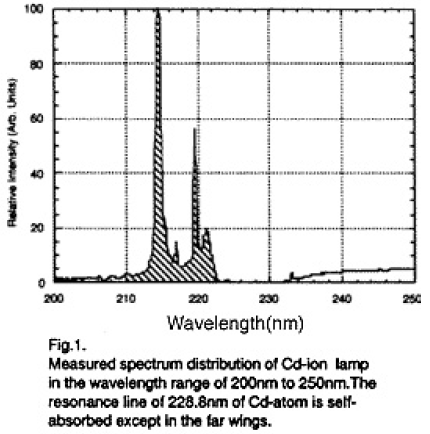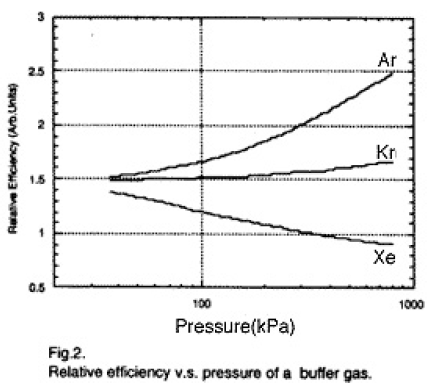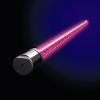光技術情報誌「ライトエッジ」No.3(1995年秋発行)
特集 第7回光源の科学と技術に関する国際会議
(当社発表論文)
高効率カドミウムイオンランプ
CADMIUM ION LAMPS WITH HIGH RADIANT EFFICIENCY
技術研究所 応用開発部 山口明康
あらまし
近年、表面改質、光CVD、アッシング、UVキュアリング、光リソグラフィーなどの用途に向けてUV-B或いはUV-C領域の工業的価値が注目されている。従来、カドミウムを用いたランプにはカドミウム原子の共鳴線である228.8nmが使われてきた。しかし、この共鳴線は自己吸収が強いのでランプは低圧で動作させざるを得なかった。そのため、このようなランプでは高輝度は期待できない。このようなことから、我々は自己吸収が、弱く高輝度が期待できるイオンの共鳴線に着目した。カドミウムイオンの数密度はカドミウム蒸気圧とランプ電流の上昇に従って増加する。カドミウムイオンは、カドミウム原子の共鳴線のより短波長側の214.4nmにやはり共鳴線を持つ。その上、カドミウムイオンの共鳴線はイオン密度が、上昇しても原子の共鳴線のように自己吸収が大きくならないので、UV-C領域で強い発光が得られることになる。従って、カドミウムイオンランプは様々な工業的要求に応えることが出来る。我々は、カドミウムイオンランプの放射効率向上について様々な検討を加えた。
本実験では、溶融石英製のバルブ中に約5mmの間隙をあけて電極を対向配置したランプに約2kW入力した。ランプの中のカドミウムの密度はおよそ3.5×1024m-3である。Ar、Kr、Xeをバッファーガスとして用いた場合、バッファーガスの圧力を変化させることでカドミウムイオンランプのUV-C領域での放射効率がどのように変化するかを調べた。その結果、電解電圧の高いガスほど放射効率が上昇するという結果が得られた。特に、Arを用いた場合、ガス圧の上昇に伴って放射効率が、上昇することが分かった。次に、それぞれの場合のアークの温度をBoltzmann-plotにより分光測定から求めた。その結果、ガス温度はXe、Kr、Arの順に高くなること、また、ガス圧の上昇に伴ってガス温度が上がることが分かった。更に、サハの式を用いて、求めたアーク温度によりカドミウムイオンの密度が、どのように変化しているかを計算した。その結果、カドミウムイオン密度の増加と、UV-C領域での放射効率の上昇とが、非常によく一致していることが判明した。このことから、カドミウムイオン密度の増加がUV-C領域での放射効率の上昇をもたらすものであることが検証された。
CADMIUM ION LAMPS
WITH HIGH RADIANT EFFICIENCY
Akiyasu Yamaguchi,Yukio Yasuda and Tatsumi Hiramoto
USHLO Inc.1194 Sazuchi,Bessho-cho,Himeji,Japan.
Introduction
Since early in thls century, characteristics of absorption or emission of cadmium lamps have been studied1)2).Recently, It was suggested that the cadmium ion lamps could be used for industrial applications, such as UV-surface modification, photo-CVD, ashing, UV-curing or photolithography3), since cadmium ion lamps have strong emission line in the short wavelength region of UV-C(far deep UV).Conventional cadmium lamps could not be used, however, because their radiant intensity in this wavelength region was too weak for practical use.Therefore, it becomes important to increase both radiant intensity and efficiency in far deep UV.Many investigations have been done in order to realize a lamp with high radiant intensity in the far deep UV region.A cadmium lamp emits the resonance line of 228.8nm.However,since the line becomes weak at high pressures by self-absorption, the maximum intensity is not high.
In this paper, cadmium ion lamps with both an intensively high radiance and a high radiant efficiency is reported.
Lamp Characteristics and Discussions
Spectral irradiance was measured by spectrometer with a Czerny-Turner mounting calibrated by a standard deuterium lamp and a standard halogen lamp. The bulb of cadmium ion lamps was made of fused quartz and the lamps were operated at about 2kW.The radiant efficiency η can be defined with the measured spectral irradiance and input power as

where
- JL,VL ;lamp current, lamp voltage, respectively
- r ;distance from the lamp
- Iλ ;measured spectral irradiance at wavelength λ
- λ1,λ2 ;lower and upper limits of the wavelength of an integration, respectively.
One of spectral distribution of the cadmium ion lamps is shown in Fig.1 as an example.In general, the spectral distribution depends upon the ionic density and the arc temperature. The ionic density is determined from Saha's equation.As a result the spectral distribution varies with the arc temperature and the filling amount of cadmium in the lamp.The resonance line of 214.4nm of the cadmium ion is dominant as shown in Fig.1.However, the atomic resonance line of 228.8nm is absolutely self-absorbed except in the far wings.An ionic line of 2l9.5nm is observed.A line of 2l6.8nm may be a satellite line of the ionic resonance line.Radiant efficiency was obtained by Eq.(1) integrated from 2l0nm to 225nm(hatched area in Fig.1).Figure 2 shows relative radiant efficiency as a function of the fil1ed gas pressure of three kinds of the rare gas as a buffer gas at room temperature.Figure 2 indicates that the radiant efficiency increases with the rise in ionization energy of the rare gas.In case of argon as a buffer gas, the radiant efficiency increases as the pressure rises.


In general, the radiant efficiency is high at high-arc temperatures. Moreover, the efficiency increases with the rise in the ionization energy of the buffer gas, since the cadmium ionic density becomes higher with the increase in the ionization energy of the buffer gas.From Saha’s equation of the mixture of cadmium with a rare gas, it is understood that the cadmium ionic density increases with the rise in ionization energy of the buffer gas even at a constant temperature.
It is found that using a rare gas with a high ionization energy in high pressures makes radiant efficeincy high.When the argon gas is used as a buffer gas, the increasing gas pressure causes high radiant efficiency.Thus, it can realize the radiant efficiency of 1.5% or more. Higher radiant efficiency may be expected with a synthetic-quartz bulb.
In general, ionic lines have weak selfabsorption, because the density of ionic absorbing species steeply decreases with the reduction in temperature in the periphery of the arc.
Conclusion
The resonance line of cadmium ions(214.4nm)can be very strong and the radiant efficiency becomes high.Ionic resonance lamps emit high-intensity radiation if the operation condition for the atomic density and the arc temperature is optimized.The cadmium ionic lamps can be applied to a wide range of applications including photo-CVD and photolithography.


